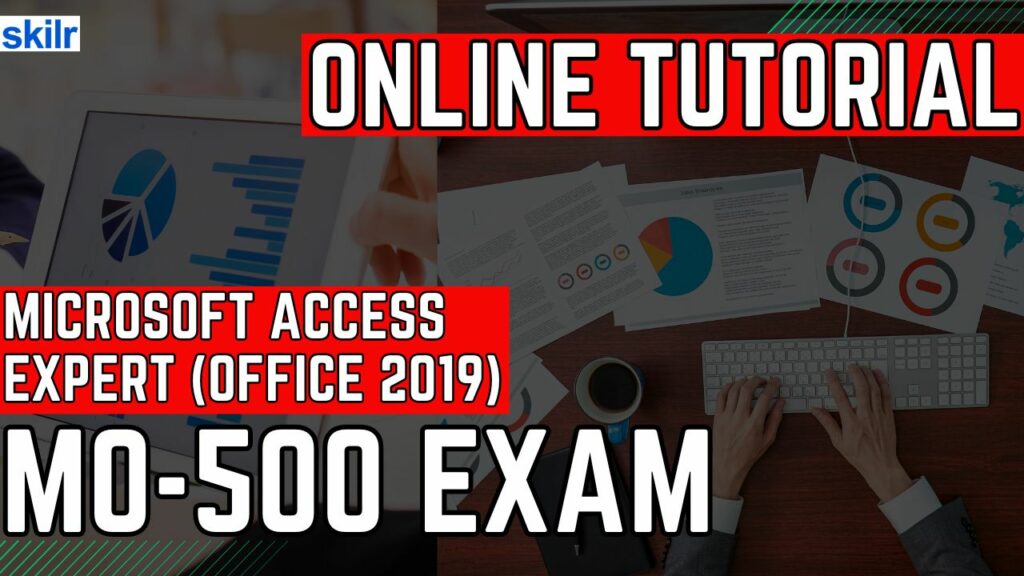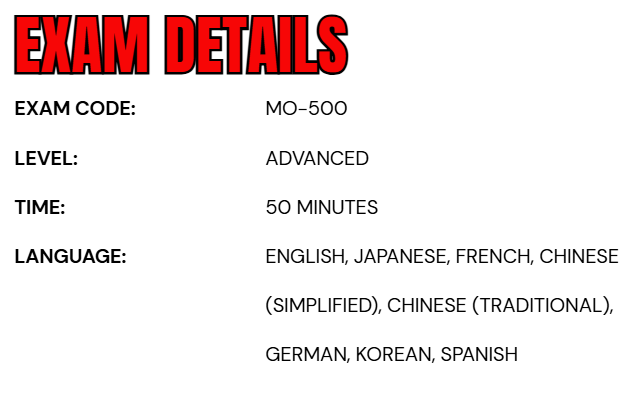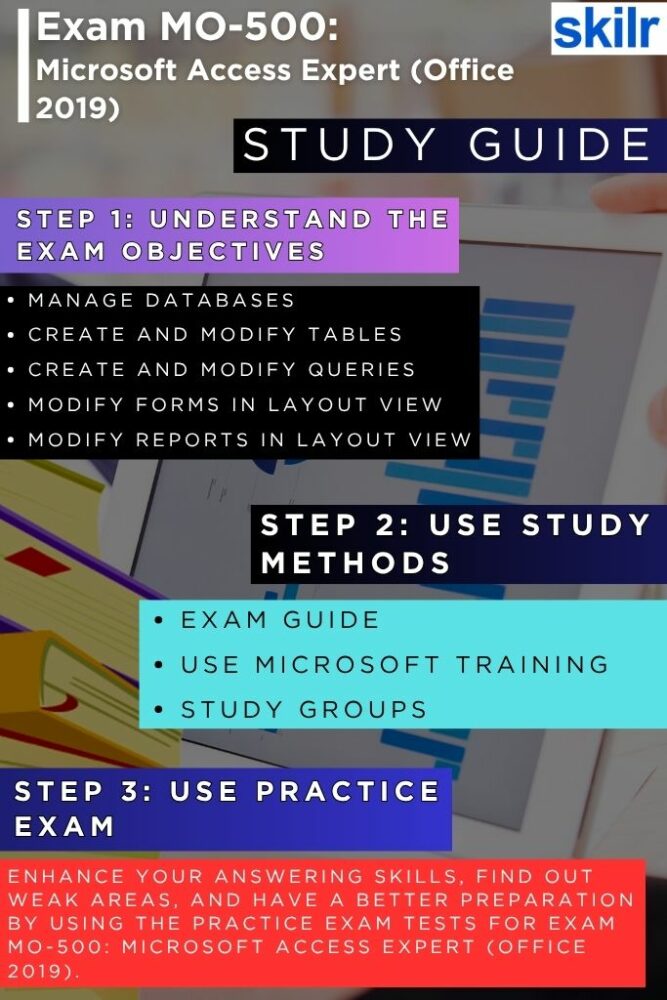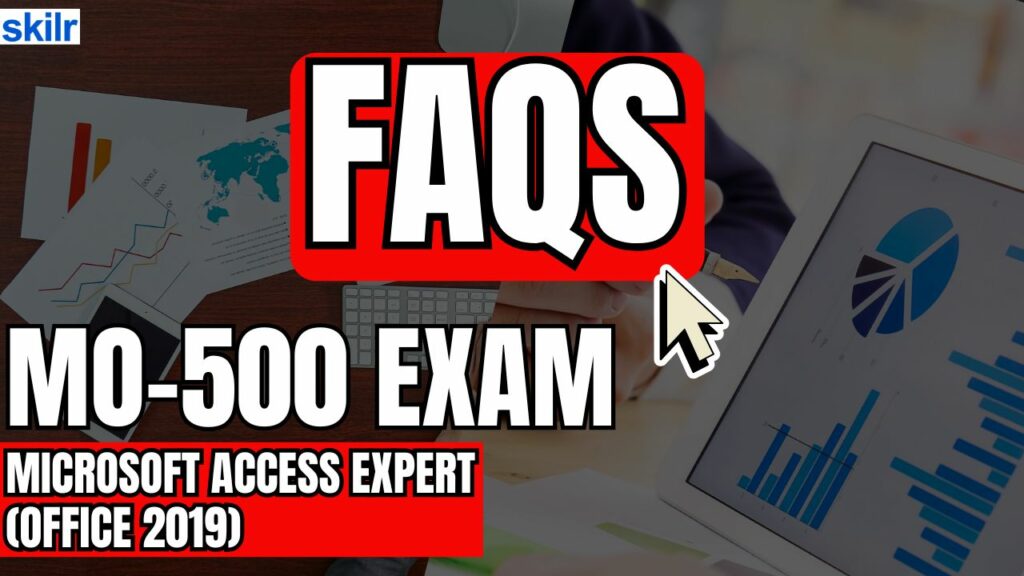
The MO-500: Microsoft Access Expert (Office 2019) certification validates a candidate’s advanced proficiency in using Microsoft Access 2019. This exam assesses the ability to utilize the software’s core and expert-level features to design and manage databases effectively. Candidates are expected to demonstrate expertise in the following areas:
- Creating and Managing Database Objects:
- Building and maintaining components such as tables, queries, forms, and reports within an Access database.
- Applying Database Design Principles:
- Understanding relational database concepts, normalization, and proper structuring to ensure data integrity and efficiency.
- Utilizing Advanced Features:
- Working with multi-table queries, generating complex reports, and establishing table relationships to support data analysis and decision-making.
– Examples of Database Objects Covered
- Tables
- Relationships
- Data Entry Forms
- Multi-Level Reports
- Multi-Table Queries
– Recommended Experience
To succeed in this certification exam, candidates should:
- Have completed approximately 150 hours of formal instruction and practical experience with Microsoft Access 2019.
- Demonstrate expert-level proficiency in applying Access features to real-world scenarios.
- Be prepared for entry-level roles in database management or related positions in the job market.
Exam Details

The MO-500: Microsoft Access Expert (Office 2019) certification exam is designed for advanced-level candidates, particularly those in business user roles who require expertise in database management and application within Microsoft Access. The assessment has a duration of 50 minutes and is proctored, meaning it is supervised and must be completed without reference materials, as it is not an open-book exam. In addition to standard questions, candidates may be required to complete interactive tasks to demonstrate their hands-on proficiency. This exam is available in multiple languages, including English, Japanese, French, Simplified Chinese, Traditional Chinese, German, Korean, and Spanish.
Course Outline
The exam covers the following topics:
1. Learn about managing databases
Modifying the database structure
- Importing objects or data from other sources (Microsoft Documentation: Import data from data sources (Power Query))
- Deleting database objects (Microsoft Documentation: Adding and Removing Access Database Files (AccessToSQL))
- Hiding and displaying objects in the Navigation Pane (Microsoft Documentation: Use the Navigation Pane)
Managing table relationships and keys
- Understanding relationships (Microsoft Documentation: How to define relationships between tables in an Access database)
- Displaying relationships (Microsoft Documentation: Guide to table relationships)
- Setting primary keys (Microsoft Documentation: Add a primary key to a table in Access)
- Enforcing referential integrity (Microsoft Documentation: Create, edit or delete a relationship)
- Setting foreign keys
Printing and exporting data
- Configuring print options for records, forms, and reports (Microsoft Documentation: Set print options in Access)
- Exporting objects to alternative formats (Microsoft Documentation: Export data to a text file)
2. Creating and modifying tables
Creating tables
- Importing data into tables (Microsoft Documentation: Import database objects into the current Access database)
- Creating linked tables from external sources (Microsoft Documentation: Manage linked tables)
- Importing tables from other databases
Managing tables
- Hiding fields in tables (Microsoft Documentation: Show or hide columns in a datasheet)
- Adding total rows
- Adding table descriptions (Microsoft Documentation: Create a table and add fields)
Managing table records
- Finding and replacing data (Microsoft Documentation: Use the Find and Replace dialog box to change data)
- Sorting records (Microsoft Documentation: Report.OrderBy property (Access))
- Filtering records (Microsoft Documentation: Apply a filter to view select records in an Access database)
Creating and modifying fields
- Adding and removing fields (Microsoft Documentation: Add or delete a column in a datasheet)
- Adding validation rules to fields (Microsoft Documentation: Restrict data input by using validation rules)
- Changing field captions (Microsoft Documentation: Modify your new database created from a template)
- Changing field sizes
- Changing field data types (Microsoft Documentation: Modify or change the data type setting for a field)
- Configuring fields to auto-increment (Microsoft Documentation: Add an AutoNumber field as a primary key)
- Setting default values
- Applying built-in input masks (Microsoft Documentation: Control data entry formats with input masks)
3. Understand about creating and modifying queries
Creating and running queries
- Creating simple queries (Microsoft Documentation: Create a query, form, or report in Access)
- Creating basic crosstab queries (Microsoft Documentation: Introduction to queries)
- Creating basic parameter queries
- Creating basic action queries
- Creating basic multi-table queries
- Saving queries
- Running queries (Microsoft Documentation: Run a query)
Modifying queries
- add, hide, and remove fields in queries (Microsoft Documentation: Add a field to a form or report)
- sort data within queries (Microsoft Documentation: Save a sort order with a table, query, form, or report)
- Filtering data within queries (Microsoft Documentation: Filter data in a query)
- Formatting fields within queries
4. Modifying forms in the layout view
Configuring form controls
- add, move, and remove form controls (Microsoft Documentation: Move and resize controls independently)
- Setting form control properties
- Adding and modifying form labels (Microsoft Documentation: Create mailing labels in Access)
Formatting forms
- Modifying tab order on forms (Microsoft Documentation: Set the tab order for controls)
- Sorting records by form field (Microsoft Documentation: OrderBy Property)
- Modifying form positioning
- Inserting information in form headers and footers
- Inserting images on forms
5. Learn how to modifying reports in the layout view
Configuring report controls
- group and sort fields on reports (Microsoft Documentation: Create a grouped or summary report)
- add report controls (Microsoft Documentation: Add a field to a form or report)
- Adding and modifying labels on reports (Microsoft Documentation: Modify, edit, or change a report)
Format reports
- Formatting a report into multiple columns
- Modifying report positioning (Microsoft Documentation: Modify, edit, or change a report)
- Formatting report elements (Microsoft Documentation: Guide to designing reports)
- Changing report orientation
- Inserting information in report headers and footers
- Inserting images on reports
Microsoft MO-500 Exam FAQs
Microsoft Certification Exam Policies
To uphold the credibility and international recognition of its certification programs, Microsoft enforces a set of standardized policies for all certification exams, whether taken online or in person.
MOS Exam Retake Policy
Candidates who do not pass a Microsoft Office Specialist (MOS) exam must observe a 24-hour waiting period before attempting the exam again. If a second attempt is also unsuccessful, a 48-hour waiting period is required for each subsequent retake. While there is no limit to the number of retakes, Microsoft strongly discourages retaking an exam that has already been passed, unless there is a specific requirement to do so.
Rescheduling and Cancellation Policy
Exam appointments may be rescheduled or canceled free of charge if the request is made at least six business days prior to the scheduled exam date. Requests made within five business days may incur a rescheduling or cancellation fee. If an appointment is canceled within 24 hours of the exam or the candidate fails to appear, the exam fee will be forfeited. In the event of a documented emergency, exceptions to this policy may be granted on a case-by-case basis.
Microsoft MO-500 Exam Study Guide

Step 1: Understand the Exam Objectives Thoroughly
Begin your preparation by gaining a clear understanding of the official exam objectives. The MO-500 exam is designed to assess your ability to use Microsoft Access 2019 at an expert level, including creating and managing complex database structures, building advanced queries, designing forms and reports, and applying database design best practices. Review the official Microsoft Skills Outline or exam guide available on the Microsoft Learn website. Familiarize yourself with each skill area, such as managing database objects, building advanced forms and reports, and ensuring data integrity. Breaking down the objectives into smaller topics will help you target your study efforts more effectively.
Step 2: Utilize Microsoft’s Official Training Resources
Microsoft provides a wealth of official training resources to help candidates prepare for their certification exams. These include self-paced learning paths available through Microsoft Learn, interactive modules, video tutorials, and official textbooks. These materials are aligned with the actual exam content and are regularly updated by Microsoft to reflect any changes in software or exam structure. Start with the foundational modules, then progress to more advanced topics, ensuring you complete exercises and quizzes to test your comprehension. Using these resources guarantees that you are studying relevant and up-to-date material.
Step 3: Join Online Study Groups and Communities
Engaging with others preparing for the same exam can significantly enhance your learning experience. Join online forums, social media groups, or professional communities focused on Microsoft certifications or the MO-500 exam specifically. Platforms such as Reddit, LinkedIn groups, Microsoft Tech Community, and certification forums often host discussions, share useful resources, and offer tips from candidates who have already taken the exam. Collaborating with peers allows you to ask questions, clarify doubts, and stay motivated throughout your preparation journey.
Step 4: Take Practice Exams to Assess Your Readiness
One of the most effective ways to prepare for the MO-500 exam is by taking high-quality practice tests. These simulate the actual exam environment and help you evaluate your understanding of key concepts under timed conditions. Look for reputable practice test providers or use those recommended by Microsoft or Certiport. Analyze your results carefully to identify areas where you need improvement. Focus your revision on these weak spots, and continue practicing until you consistently achieve high scores. Practice exams also help reduce exam-day anxiety by familiarizing you with the question formats and time constraints.
Step 5: Review and Refine Your Skills
As your exam date approaches, focus on refining your skills by revisiting challenging topics and applying what you’ve learned in hands-on practice. Work on real Access projects or case studies to deepen your practical understanding. Ensure you’re confident in using features like multi-table queries, subforms, calculated controls, and report grouping levels. Make use of checklists based on the exam objectives to confirm that you’ve covered every topic thoroughly.


